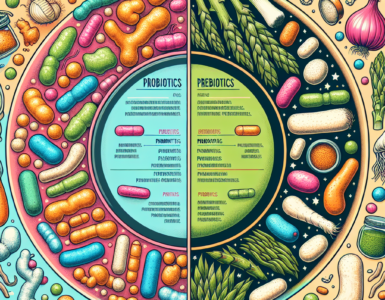Introduction to Electrolytes
Electrolytes are minerals with an electric charge, essential for many bodily functions. They are found naturally in the body and play critical roles in maintaining fluid balance, nerve signaling, and muscle function.
What Are Electrolytes?
Electrolytes include several minerals such as sodium, potassium, calcium, magnesium, chloride, phosphate, and bicarbonate. These charged particles can conduct electricity when dissolved in water, which is why they are termed ‘electrolytes.’ They are pivotal for the electrical activity necessary for various bodily processes.
| Key Electrolytes | Charge | Primary Function |
|---|---|---|
| Sodium (Na+) | Positive | Regulate fluid balance |
| Potassium (K+) | Positive | Nerve signal transmission |
| Calcium (Ca2+) | Positive | Muscle contractions |
| Magnesium (Mg2+) | Positive | Muscle and nerve function |
| Chloride (Cl-) | Negative | Fluid balance and digestion |
| Phosphate (PO4^3-) | Negative | Energy storage |
| Bicarbonate (HCO3-) | Negative | pH balance |
The Importance of Electrolytes in the Body
Electrolytes are vital for several physiological functions. They help to regulate fluid balance by determining the flow of water across cell membranes, which is crucial for maintaining hydration levels. Electrolytes are also indispensable for muscle contractions, including those necessary for the heart to beat effectively.
In the nervous system, electrolytes facilitate nerve signal transmission by creating electrical impulses. This is essential not just for muscle contractions but for all neural activity, including brain function. Furthermore, they contribute to maintaining the body’s pH levels and are involved in the enzymatic reactions that provide energy for the body.
Maintaining adequate electrolyte levels is especially important for individuals engaging in regular physical activity. Electrolytes and exercise are closely linked, as physical exertion increases the need for these minerals due to their loss through sweat and the greater demand placed on the body’s physiological systems.
Electrolytes and Exercise
Electrolytes play a pivotal role in maintaining optimal body function, particularly during physical activity. Their significance in exercise cannot be overstated, as they are essential for muscle function and hydration—two critical factors in athletic performance.
The Role of Electrolytes in Muscle Function
Electrolytes such as potassium, sodium, calcium, and magnesium are vital for muscle contractions. When these minerals are at appropriate levels within the body, muscles function more effectively. They facilitate the electrical signals that instruct muscles to contract and relax, and this is particularly important during exercise where frequent and precise muscle contractions are required.
The balance of electrolytes is crucial for preventing muscle fatigue and cramps, conditions that can hinder athletic performance. An imbalance can disrupt the electrical communication to the muscles, causing involuntary contractions or spasms known as cramps.
To illustrate the relevance of electrolytes in muscle function, consider the following table showing the role of different electrolytes in muscular activity:
| Electrolyte | Role in Muscle Function |
|---|---|
| Sodium | Regulates muscle contraction and nerve function |
| Potassium | Works with sodium to maintain fluid balance and nerve signals |
| Calcium | Essential for muscle contractions and strength |
| Magnesium | Helps with muscle relaxation and reduces cramping |
How Electrolytes Affect Hydration
Electrolytes also have a significant impact on hydration levels, which are critical during exercise. They help retain fluids in the body, ensuring that cells remain sufficiently hydrated. Proper hydration facilitates cardiovascular function, temperature regulation, joint lubrication, and nutrient transport—all essential for exercise performance.
Sodium, in particular, helps to maintain fluid balance by retaining water in the body. When the balance of sodium and other electrolytes is disrupted, it can lead to dehydration, even if one is drinking plenty of water. This is because without adequate electrolytes, the body cannot hold onto the water it needs.
The following table demonstrates how each electrolyte contributes to hydration:
| Electrolyte | Function in Hydration |
|---|---|
| Sodium | Helps to retain water, maintaining fluid balance |
| Chloride | Works with sodium to help keep fluid balance |
| Potassium | Balances fluids inside and outside of cells |
| Magnesium | Supports cellular hydration and energy production |
Understanding the interplay between electrolytes and exercise underscores the importance of maintaining electrolyte balance, especially for those engaged in regular physical activity. Proper electrolyte levels support muscle function and hydration, both of which are critical for achieving peak exercise performance.
Losing Electrolytes Through Sweat
Understanding the relationship between sweat and electrolyte loss is crucial for individuals who engage in regular physical activity. As the body exerts itself during exercise, it naturally begins to sweat as a means of cooling down. However, this process does more than regulate body temperature—it also leads to the depletion of essential electrolytes.
The Connection Between Sweat and Electrolyte Loss
Sweat is composed of water and various minerals, including key electrolytes such as sodium, potassium, chloride, and magnesium. These electrolytes are vital for numerous bodily functions, particularly during physical exertion. When an individual sweats, they are not only losing fluids but also these important minerals. The amount of electrolytes lost can vary significantly based on factors like exercise intensity, duration, ambient temperature, and individual sweat rates.
| Electrolyte | Average Amount Lost in Sweat (mg/L) |
|---|---|
| Sodium | 900 – 1300 |
| Potassium | 200 – 300 |
| Chloride | 1100 – 1500 |
| Magnesium | 10 – 20 |
Impact of Electrolyte Imbalance During Exercise
The loss of electrolytes through sweat can lead to an imbalance that affects exercise performance and overall health. Electrolytes are responsible for conducting electrical impulses that power muscle contractions, maintaining fluid balance within cells, and ensuring proper blood pH levels. When these mineral levels drop too low, it can lead to a range of issues.
- Muscle Function: An imbalance can result in muscle weakness, cramps, and spasms, which can hinder an individual’s ability to maintain exercise intensity or even continue the activity.
- Hydration: A drop in electrolytes can disrupt the balance of fluids in and out of cells, potentially leading to dehydration despite adequate water intake.
- Cardiovascular System: Electrolytes help to maintain heart function, and an imbalance can cause irregular heartbeats or palpitations.
- Cognitive Function: An individual may experience confusion, dizziness, or difficulty concentrating, which can be dangerous during physical activities.
Recognizing the signs of electrolyte imbalance and knowing how to replenish these vital minerals is essential for anyone who participates in exercise, especially those who do so on a regular basis. Proper management of electrolyte levels can help to enhance performance, reduce recovery time, and prevent health complications related to mineral deficiencies.
Identifying Signs of Electrolyte Imbalance
Electrolytes play a pivotal role in maintaining homeostasis within the body, especially for those who regularly participate in physical activities. An imbalance can disrupt various bodily functions, leading to noticeable symptoms and potentially severe health risks if not addressed.
Common Symptoms of Electrolyte Imbalance
An individual experiencing an electrolyte imbalance may exhibit a variety of signs. These symptoms can range from mild to severe and should be taken seriously as they affect exercise performance and overall well-being.
The following table outlines common symptoms associated with an electrolyte imbalance:
| Symptom | Possible Related Electrolyte Imbalance |
|---|---|
| Muscle cramps and spasms | Sodium, Magnesium |
| Fatigue | Potassium, Calcium |
| Dizziness | Sodium, Potassium |
| Irregular heartbeat | Potassium, Magnesium |
| Nausea and vomiting | Sodium, Potassium |
| Confusion | Sodium, Calcium |
| Headaches | Sodium, Magnesium |
| Thirst | Sodium |
While this is not an exhaustive list, these symptoms are indicative of an imbalance and should prompt individuals to assess their electrolyte intake and hydration status.
Long-Term Risks of Ignoring Electrolyte Levels
Neglecting the signs of an electrolyte imbalance can lead to long-term health implications. Continuously low levels of electrolytes can impair critical bodily functions, and if left unchecked, may result in the following conditions:
| Long-Term Risk | Description |
|---|---|
| Hyponatremia | An abnormally low level of sodium in the blood, which can lead to swelling of cells and an increased risk of brain edema. |
| Hyperkalemia | Elevated potassium levels that can affect cardiac function, potentially leading to arrhythmias. |
| Osteoporosis | A deficit in calcium over time can weaken bones, increasing the risk of fractures and osteoporosis. |
| Kidney Stones | An imbalance of calcium and other minerals can contribute to the formation of kidney stones. |
| Muscle Weakness | Chronic low levels of key electrolytes can lead to persistent muscle weakness and decreased physical performance. |
It is imperative for individuals who are active to be cognizant of these risks. Proper management of electrolyte levels through diet or supplementation can help mitigate these long-term health issues. As part of a comprehensive approach to health and exercise performance, recognizing and addressing electrolyte needs is essential.
Replenishing Electrolytes for Optimal Performance
To maintain peak performance during physical activities, it’s essential to replenish electrolytes that are lost through sweat. Understanding natural sources of electrolytes and when to consider supplementation can help individuals effectively manage their levels.
Natural Sources of Electrolytes
Many foods and beverages are rich in electrolytes such as sodium, potassium, calcium, magnesium, and chloride. These electrolytes are vital for various bodily functions, including muscle contraction, nerve signaling, and hydration. Incorporating a variety of these natural sources into one’s diet can help maintain a healthy electrolyte balance, especially for those who engage in regular exercise.
| Electrolyte | Natural Sources |
|---|---|
| Sodium | Table salt, cheese, bread, and processed foods |
| Potassium | Bananas, oranges, potatoes, and spinach |
| Calcium | Dairy products, leafy greens, and fortified cereals |
| Magnesium | Nuts, seeds, whole grains, and leafy greens |
| Chloride | Table salt and vegetables like tomatoes and celery |
A balanced diet that includes these foods can usually meet the electrolyte needs of an individual. However, during intense or prolonged exercise, additional replenishment may be necessary.
When to Consider Electrolyte Supplementation
Electrolyte supplementation may be necessary when an individual experiences significant electrolyte loss, which typically occurs during long-duration exercises, high-intensity workouts, or activities in hot and humid conditions. Athletes or fitness enthusiasts who perspire heavily may also need to pay closer attention to their electrolyte intake.
Supplementation should be considered in the following scenarios:
- Extended workouts exceeding one hour
- Excessive sweating
- Exercise in extreme temperatures
- Symptoms of electrolyte imbalance, such as muscle cramps or fatigue
When choosing an electrolyte supplement, it is important to look for a balance of necessary electrolytes without excessive sugars or artificial ingredients. They come in various forms, including tablets, powders, and ready-to-drink beverages. It is crucial to follow the recommended usage guidelines to avoid an imbalance, which can be just as detrimental as a deficiency.
Maintaining a balance of electrolytes is a key factor in achieving and sustaining optimal exercise performance. By recognizing the signs of electrolyte imbalance and understanding when to incorporate natural sources or supplements, individuals can support their body’s needs and ensure they are equipped for their physical pursuits.
Balancing Electrolytes for Different Types of Exercise
The demands of physical activity on the body’s electrolyte balance can vary greatly depending on the type and intensity of the exercise. Understanding how to manage electrolyte levels is crucial for enhancing athletic performance and preventing potential health issues.
Endurance Sports and Electrolyte Needs
Endurance sports such as marathons, triathlons, and long-distance cycling challenge athletes to maintain performance over extended periods. These activities can lead to significant electrolyte depletion, primarily through prolonged sweating.
Electrolyte management is a critical component for endurance athletes. They must ensure that their intake matches their output to avoid conditions like hyponatremia (low sodium levels) or muscle cramps. The table below provides a general guideline on the approximate amounts of different electrolytes lost during an hour of endurance exercise, which can help in planning their replenishment:
| Electrolyte | Approximate Loss per Hour (mg) |
|---|---|
| Sodium | 500-700 |
| Potassium | 80-120 |
| Calcium | 20-40 |
| Magnesium | 10-20 |
It is advisable for individuals participating in endurance sports to consume electrolyte-rich fluids or snacks that can help them sustain their electrolyte balance throughout the event. Regular monitoring of hydration status and electrolyte levels can aid in tailoring intake for individual needs.
High-Intensity Training and Electrolyte Replenishment
High-Intensity Interval Training (HIIT) and other forms of intense, short-duration workouts can also deplete electrolyte stores, although the mechanisms and rates of loss may differ from endurance sports. Rapid and intense muscle contractions require a constant and swift exchange of electrolytes to sustain performance and prevent fatigue.
During high-intensity exercise, the rate of sweat production can be high, leading to a significant, though usually less prolonged, loss of electrolytes. Athletes may experience acute symptoms of imbalance such as muscle twitches, weakness, or fatigue. The following table illustrates typical electrolyte losses during an hour of high-intensity training:
| Electrolyte | Approximate Loss per Hour (mg) |
|---|---|
| Sodium | 800-1500 |
| Potassium | 200-500 |
| Calcium | 40-100 |
| Magnesium | 20-40 |
Replenishing electrolytes shortly after high-intensity training can help in rapid recovery and preparation for subsequent exercise sessions. Consuming a balanced electrolyte solution or a recovery snack that includes a mix of sodium, potassium, calcium, and magnesium can be beneficial for restoring electrolyte balance.
In conclusion, both endurance athletes and those engaging in high-intensity training must be vigilant about their electrolyte intake. Tailoring electrolyte replenishment to the specific demands of the exercise type is essential for maintaining optimal physiological function and achieving peak performance.
Practical Tips for Managing Electrolyte Levels
Maintaining balanced electrolyte levels is crucial for individuals who are active and wish to optimize their exercise performance. Here are practical tips on hydration strategies and recognizing personal electrolyte needs.
Hydration Strategies Before, During, and After Exercise
Proper hydration is essential for overall health, especially when it comes to maintaining electrolyte balance during physical activity. Here are strategies to ensure you stay hydrated and your electrolytes are replenished:
Before Exercise:
- Start hydrating at least 2-3 hours before engaging in exercise to ensure your body is well-prepared and electrolytes are at optimal levels.
During Exercise:
- Drink water regularly throughout your workout. Incorporate drinks that contain electrolytes if the duration exceeds 60 minutes or if you’re exercising in hot and humid conditions.
After Exercise:
- Continue to replenish fluids and electrolytes after exercising to restore any losses incurred during physical activity. Rehydration should begin soon after exercise completion.
| Time Frame | Fluids (oz) |
|---|---|
| 2-3 hours before exercise | 17-20 |
| Every 10-20 minutes during exercise | 7-10 |
| Within 30 minutes post-exercise | 16-24 for every pound lost |
Recognizing Personal Electrolyte Needs
Everyone’s body is unique, therefore, recognizing one’s personal electrolyte needs is a fundamental aspect of managing electrolyte levels effectively. Consider the following factors:
- Sweat Rate: Individuals with a high sweat rate are at a higher risk of electrolyte loss.
- Environment: Hotter climates increase sweat production, which can lead to greater electrolyte depletion.
- Exercise Duration and Intensity: Longer and more intense workouts typically require more vigilant electrolyte management.
- Personal Health: Certain health conditions can affect electrolyte balance and may necessitate a tailored approach to electrolyte replenishment.
To assess personal electrolyte requirements, monitoring fluid loss through sweat can be a practical method. Weighing oneself before and after exercise gives an indication of the amount of fluid lost, and hence, how much needs to be replenished.
In conclusion, managing electrolyte levels is a pivotal part of maintaining peak physical function during exercise. By implementing targeted hydration strategies and recognizing personal electrolyte needs, individuals can enhance their exercise performance and overall well-being.
Disclaimer: This content is for informational purposes only and is not intended as medical advice or a substitute for professional healthcare consultation. Before making any changes to your hydration or electrolyte intake, especially if you engage in regular physical activity, consult with a healthcare professional or a qualified sports nutritionist. Individual needs may vary, and professional guidance is crucial to ensure that any dietary adjustments are safe and effective for your specific health conditions and activity levels. Use of this information is at your own risk.











